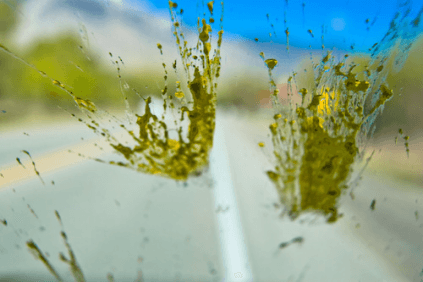During the summer; tarp, sap and bugs can easily contaminate the surface of the car. During those months, billions of insect eggs have hatched, while trees produce more sap. The hot temperature and intense sunlight could soften the asphalt, causing bits of soft asphalt to get attached at the lower parts of our car. It should be noted that decomposed insect innards are acidic, causing damages to trim and paint. During the summer time, especially if we have just driven on freshly repaired roads, we should check our car for speckles of oils and asphalt. Small balls of soft asphalts can be kicked by vehicles in front of us.
Asphalt is a rather nasty type of petroleum-based product and even with plenty of washing, we won’t be able to remove much of it. Eventually, ugly small spots could start to accumulate, running the whole appearance of our car. An effective solvent designed for asphalts are needed for this purpose. Removers may contain specific petroleum distillates, mineral spirits and kerosene. We may also need to regularly coat our car with lubricants to protect it from asphalt, so it can easily be removed. For extremely stubborn contamination, we may need to use paint-cleaning polishes.
Removing tree sap could be quite difficult and if we don’t remove it quickly, it could harden like tar. However, because tree sap is a fresh organic material, we should be able to remove it with and mineral spirits can work as a solvent to dissolve the sap. Again, removing it can be quite difficult if the sap has been left in the open for more than a few days. In this case, the first thing to do is to remove the hard, outer shell of the sap spots with paint rubbing compound. We should do this slowly until the shell is removed and mineral spirit should allow us to clean away the remaining parts of the spot. In general, if we are still unable to remove saps with mineral spirits, then we will need rubbing compound. When we are doing this, it is important to apply light pressure, so we won’t scratch the paint. After we remove the sap spots, it is important to buff the surface with proper polish to remove any mark. It may be necessary to re-wax the whole surface of the car to make sure that we are getting even results.
Head-on collision with hundreds of insects could be disastrous for both those bugs and our car. Insects have exoskeleton that could burst when it impacts the windshield and car surface. Shellac is actually the byproducts of insects and when it is splattered on our car, it is possible that the car paint will be damaged. If we fail to remove these bugs, the calcified remains can be quite difficult to remove without proper cleaning solutions. Improper cleaning methods with only water and cloth may actually scratch the paint. What we need is a special solvent that can loosen and dissolve those remains.
